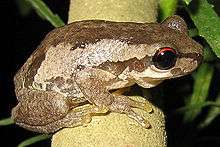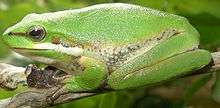Litoria
Litoria is a genus of Pelodryadidae tree frogs native to Australia, the Bismarck Archipelago, the Solomon Islands, New Guinea, the Lesser Sunda Islands, and the Moluccan Islands. It is the only genus in the monotypic subfamily Litoriinae and are sometimes collectively referred to as Australasian treefrogs. They are distinguishable from other tree frogs by the presence of horizontal irises, no pigmentation of the eyelids, and their distribution east and south from Wallacea. Over 90 species are described, but several new species are described every year on average, such as the Pinocchio frog, discovered in 2008 and described in 2019.[1][2]
| Litoria | |
|---|---|
 | |
| Bleating tree frog (Litoria dentata) | |
| Scientific classification | |
| Kingdom: | Animalia |
| Phylum: | Chordata |
| Class: | Amphibia |
| Order: | Anura |
| Family: | Pelodryadidae |
| Subfamily: | Litoriinae |
| Genus: | Litoria Tschudi, 1838 |
| Species | |
|
See text | |
The species within the genus Litoria are extremely variable in appearance, behaviour, and habitat. The smallest species is the javelin frog (L. microbelos), reaching a maximum snout–to–vent length of 1.6 cm (0.6 in),[3][4] while the largest, the giant tree frog (L. infrafrenata), reaches a size of 13.5–14 cm (5.3–5.5 in). The appearance, behaviour, and habitat of each frog is usually linked. The small, darkly coloured frogs are generally terrestrial, and never, or infrequently, climb. The larger, green species are usually arboreal and some only venture to the ground to breed.
Species
_Litoria_everetti_Meleotegi_River%2C_Ermera_District%2C_Timor-Leste_(USNM_578928).jpg)

The following species are recognised within the genus Litoria (many others have been moved to Nyctimystes and Ranoidea):[5]
- L. adelaidensis – slender tree frog
- L. albolabris – Wandolleck's white-lipped tree frog
- L. amboinensis – Horst's tree frog
- L. angiana – Angiana tree frog
- L. arfakiana – Arfakiana tree frog
- L. aurifera Anstis, Tyler, Roberts, Price & Doughty, 2010 – Kimberley rockhole frog[6]
- L. axillaris – Kimberley rocket frog
- L. biakensis Günther, 2006
- L. bibonius Kraus & Allison, 2004
- L. bicolor – northern dwarf tree frog
- L. burrowsi – Tasmanian tree frog
- L. capitula – Samlakki tree frog
- L. chloristona
- L. chloronota – Arfak Mountain tree frog
- L. chrisdahli Richards, 2007
- L. christianbergmanni
- L. congenita – Yule Island tree frog
- L. contrastens – Barabuna tree frog
- L. cooloolensis – Cooloola sedge frog, Cooloola tree frog
- L. coplandi – Copland's rock frog
- L. corbeni
- L. darlingtoni – Darlington's Madang tree frog
- L. dentata – bleating tree frog, Keferstein's tree frog
- L. dorsalis – dwarf rocket frog
- L. electrica – buzzing tree frog
- L. eurynastes
- L. everetti – Everett's tree frog
- L. ewingii – brown tree frog
- L. fallax – eastern dwarf tree frog
- L. flavescens Kraus & Allison, 2004
- L. freycineti – Freycinet's frog
- L. gasconi Richards, Oliver, Krey & Tjaturadi, 2009[7]
- L. havina
- L. hilli Hiaso and Richards, 2006
- L. humboldtorum R. Günther, 2006
- L. inermis – bumpy rocket frog
- L. iris – Western Highland tree frog
- L. jervisiensis – Jervis Bay tree frog
- L. latopalmata – broad-palmed frog
- L. leucova – West Sepik tree frog
- L. littlejohni – Littlejohn's tree frog
- L. lodesdema
- L. longicrus – Wendessi tree frog
- L. longirostris – long-snouted frog, sharp-snouted frog, scrub rocket frog
- L. lutea – Faro Island tree frog
- L. majikthise
- L. mareku
- L. megalops Richards & Iskandar, 2006
- L. meiriana – rockhole frog
- L. microbelos – javelin frog
- L. micromembrana – Nodugl tree frog
- L. modica – Oruge tree frog
- L. mucro
- L. multiplica – Kassam tree frog
- L. mystax – Moaif tree frog
- L. nasuta – striped rocket frog
- L. nigrofrenata – bridled frog
- L. nigropunctata – black-dotted tree frog
- L. oenicolen – Trauna River tree frog
- L. ollauro
- L. olongburensis – wallum sedge frog, Olongburra frog, sharp-snouted reed frog
- L. pallida – pale frog
- L. paraewingi Watson, Loftus-Hills & Littlejohn, 1971 – plains brown tree frog (also red cryptic treefrog, Victoria frog)
- L. peronii – Peron's tree frog, emerald-speckled tree frog, laughing tree frog, maniacal cackle frog
- L. personata – masked frog
- L. pinocchio – Pinocchio frog
- L. pronimia
- L. prora – Efogi tree frog
- L. pygmaea – Geelvink pygmy tree frog
- L. quadrilineata – lined tree frog
- L. revelata – revealed frog, whirring tree frog
- L. rothii – Roth's tree frog
- L. rubella – desert tree frog
- L. rubrops
- L. scabra
- L. singadanae Richards, 2005
- L. spartacus Richards & Oliver, 2006
- L. staccato – Chattering rock frog
- L. thesaurensis – Treasury Island tree frog
- L. timida – Menemsorae tree frog
- L. tornieri – Tornier's frog
- L. tyleri – Tyler's tree frog, southern laughing tree frog
- L. umarensis – Umar tree frog
- L. umbonata Tyler & Davies, 1983 – Baliem River Valley tree frog
- L. verae – Vera's tree frog
- L. verreauxii – whistling tree frog, Verreaux's tree frog
- L. viranula
- L. vivissimia
- L. vocivincens – Brown River tree frog
- L. wapogaensis
- L. watjulumensis – Watjulum frog
- L. wisselensis – Wissel Lakes tree frog
- L. wollastoni – highland tree frog
References
- Newscientist.com
- Richards, Stephen J.; Mumpuni, Mumpuni; Günther, Rainer; Oliver, Paul M. (2019-05-14). "Systematics of New Guinea treefrogs ( Litoria : Pelodryadidae) with erectile rostral spikes: an extended description of Litoria pronimia and a new species from the Foja Mountains". Zootaxa. 4604 (2): 335–348. doi:10.11646/zootaxa.4604.2.6. ISSN 1175-5334.
- Jean-Marc Hero, Dale Roberts, Paul Horner, Richard Retallick (2004). "Litoria microbelos". IUCN Red List of Threatened Species.CS1 maint: multiple names: authors list (link)
- "Javelin Frog Litoria microbelos (Cogger 1966)". Government of Western Australia. 2013.
- "Litoria Tschudi, 1838 | Amphibian Species of the World". research.amnh.org. Retrieved 2019-12-22.
- Anstis, Marion; Tyler, Michael J.; Roberts, Dale; Price, Luke C.; Doughty, Paul (2010). "A new species of Litoria (Anura: Hylidae) with a highly distinctive tadpole from the north-western Kimberley region of Western Australia" (PDF). Zootaxa. 2550: 39–57. doi:10.11646/zootaxa.2550.1.3. hdl:2440/61497.
- Richards, Stephen J.; Oliver, Paul M.; Krey, Keliopas; Tjaturadi, Burhan (2009). "A new species of Litoria (Amphibia: Anura: Hylidae) from the foothills of the Foja Mountains, Papua Province, Indonesia". Zootaxa. 2277: 1–13.
Bibliography
| Wikimedia Commons has media related to Litoria. |
| Wikispecies has information related to Litoria |
- Frogs of Australia. Litoria genus . Amphibian Research Centre.
- Frogs Australia Network search: Litoria
- Cogger, H.G. 1979. Reptiles & Amphibians of Australia. A. H. & A. W. REED PTY LTD ISBN 0-589-50108-9
- Tyler, Michael J. 1992. Encyclopedia of Australian Animals: Frogs. Angus & Robertson. ISBN 0-207-15996-3